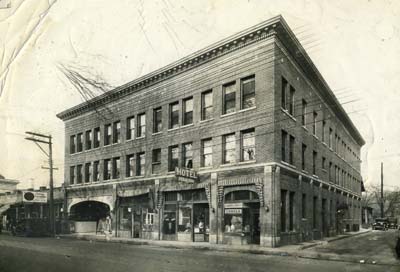"Cap" Ferguson: A Black Trailblazer
By Maria Sisco and Stan Bumgardner

The Ferguson, which opened in Charleston in 1922, was described by a local paper as "one of the foremost most modern and elaborately furnished and equipped hotels catering to Negro patronage around the country."
“Cap” Ferguson was born at Edgewater in Fayette County on October 17, 1888, the son of Daniel and Sarah Elizabeth Eddens Ferguson. His full given name at birth was Gurnett Ferguson. However, when enlisting in the Army, Cap was told he needed a middle name. According to a family story, he perused a map of the world, looked toward Europe, and randomly picked a middle name—Edinburgh.
Cap spent most of his younger years growing up in West Dunbar, just west of Charleston, and graduated from Garnet High School and the normal school of West Virginia Collegiate Institute—now West Virginia State University—in 1912. He taught school for several years in Fayette County and Huntington.
In 1914, he married Lily Foster. They remained together more than 60 years, until her death in 1975.
While training to become a teacher, he began dabbling in real estate, later recalling, “In June, 1912, I didn’t have $5. I remember that because I got in on a real estate deal with three others and $20 was needed for an option. I didn’t have my share but we succeeded in having the option reduced to $15.”
When the United States entered World War I in 1917, Cap was assigned to the 17th Provisional Training Regiment at Fort Des Moines, Iowa—the first site ever designated by the U.S. military specifically for training black officers. After three months of training in Iowa, Cap was commissioned as one of 105 African-American captains. At the same time, two other graduates of the West Virginia Collegiate Institute Normal School were commissioned second lieutenants at Fort Des Moines: Lafayette Campbell and Norwood Fairfax. Cap’s brother Daniel, later to become a dean of the West Virginia Collegiate Institute and introduce the school’s ROTC program, was in the second class of cadets at Fort Des Moines. Another brother, William, also served in the war.
Cap spent four months in basic training at Camp Grant in Rockford, Illinois, and became captain of Company M of the 365th Infantry, part of the all-black 92nd Division. According to family tradition, he was once commended by his division’s commanding general, Charles “Iron Pants” Martin—who was openly racist toward most of his soldiers—for defending a group of African-American soldiers from damaging accusations that would have destroyed their lives. In summer 1918, Cap led an all-black 1,700-troop transport across the Atlantic. As ranking officer aboard the ship, he became the only African-American to command a transport during the war, earning him the lifelong nickname “Cap.” Throughout his life, Cap Ferguson achieved his goals regardless of the odds and fought even harder when the odds were against him. So, his commanding presence certainly must have had a profound impact on the young soldiers who served with him.
Few specifics are known of Cap’s time in Europe due to the fire at the National Personnel Records Center in St. Louis in 1973. In the latter weeks of the war, the 365th was actively involved in the fighting in the Vosges. The French awarded the entire regiment the Croix de Guerre.
For years afterward, Cap spoke fondly of his time in Europe and returned home with beautiful fabrics and gifts for his Lily. He was a very civic-minded man who, in 1919, founded the first African-American American Legion post in West Virginia and was a founding member of the state’s Veterans of Foreign War.
After World War I, there were about 5,000 African-Americans in Charleston—living almost entirely in a segregated world. Cap realized that Charleston’s black community desperately needed quality businesses of its own. His brilliant idea was to build a magnificent business complex in the traditionally African-American section on the north end of the downtown. The nucleus of his Ferguson Business Center was the Ferguson Hotel.
Cap was inspired by his own experience of not being able to find an available room in New York City: “You know, a colored man who wants good lodgings has a difficult time when he is traveling. I spent an hour and a half in a taxi in New York city looking for a place to stop. I didn’t want to go to a cheap, unattractive and unsanitary colored lodging house and there was no good colored hotel.”
The Ferguson Hotel, which opened in 1922, took up an entire city block bounded by Washington, Shrewsbury, Lewis, and Broad (now Leon Sullivan Way) streets. It cost some $200,000 to build, included 72 rooms, and quickly attracted other black businesses to the area. It was designed by West Virginia’s first licensed black architect, John C. Norman of Charleston, and built by Charleston contractor J. H. Love. A local black newspaper said the Ferguson was “one of the foremost most modern and elaborately furnished and equipped hotels catering to Negro patronage around the country.”
You can read the rest of this article in this issue of Goldenseal, available in bookstores, libraries or direct from Goldenseal.